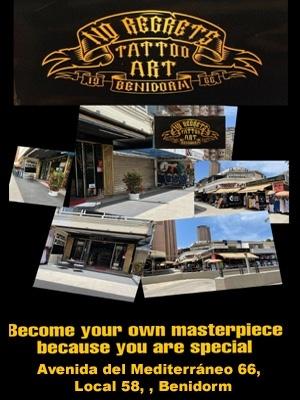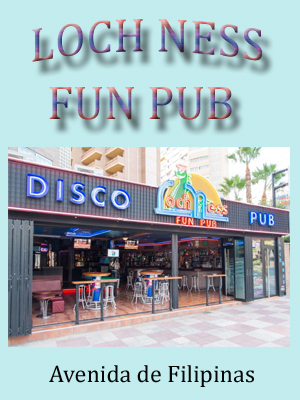Driving Routes, France to Spain
This page will proved some of the most popular driving routes from France to Spain specifically to Benidorm and the Costa Blanca.
The first thing you need to do if you’re driving to Spain is to get across the English Channel.
There are two ways to get to France from the UK with your car: you can either take the ferry from various ports in the UK or the Channel Tunnel from Folkestone.
Here are a few routes to look into, obviously there are lots of variations so these are just a guide.
Looking for somewhere to stay along the way - The motorway-side hotel chains in France are excellent for convenience and amenities. They are situated on the outskirts of most of the major towns, have free parking, are fairly clean and cheap.
When driving across the Pyrenees please Do NOT do it this way
Coronavirus Please follow all the rules of the countries you are driving through.
Official guidance about entering France from the UK can be found HERE
Driving Routes, France to Spain
Calais to Costa Blanca, toll route via Paris - Arras to Paris to Orleans to Bourges to Clermont Ferrand to Beziers to Perpignan to Barcelona to Tarragona to Valencia to BENIDORM - VIA the AP7 17 hours 34 minutes, 1,823km,
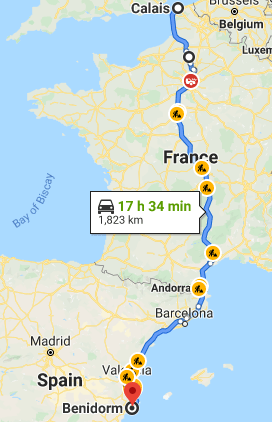
Driving Routes, France to Spain
Calais to Costa Blanca Non Toll Route - via Rouen - Tours - Poitiers - Angouleme - Bordeaux - Bayonne - into Spain -San Sebastian - Pamplona - Zaragoza - Teruel - Valencia - BENIDORM Scenic route, 21 hours 13 mins, 1,754 km
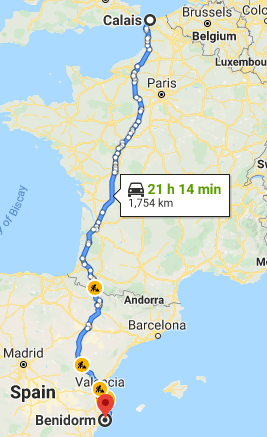
Driving Routes, France to Spain
Calais to Costa Blanca, this route has some tolls - Calais to Rouen - Orleans - Châteauroux - Limoges - Toulouse - Perpignan - border - Barcelona - Tarragona - Valencia - Direct south, mainly motorway route, some free, generally bypassing all towns & cities, 20 hours 26 minutes, 1,914 km
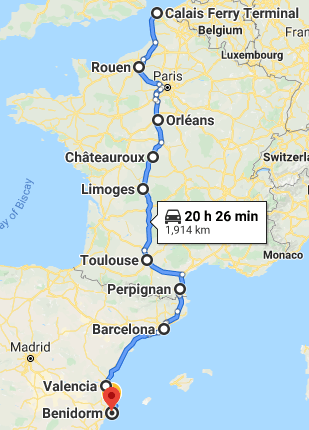
Driving Routes, France to Spain
Calais to Costa Blanca, Motorway and tolls - Calais to Reims - Dijon - Lyon - Montpelier - border - Barcelona - Tarragona - Valencia - Benidorm - 19 hours 41 minutes, 1,908 km
A lot of monotonous motorway traveling, and costly due to the tolls, but it is the best route if you want the shortest channel crossing and the simplest, sign-posted, mostly traffic-free, motorway route
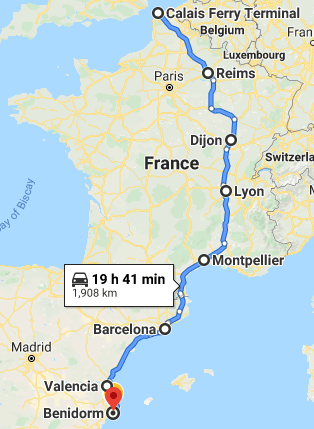
Driving Routes, France to Spain
The routes above can also be taken from Dunkirk which is 47km from Calais
From Caen/Le Harve/St Marlo or Cherbourg to Costa Blanca - Le Mans - Tours - Poitiers - Bordeaux - Langon - Pau - border - Huesca - Zaragoza - Valencia - Benidorm From Caen 17 hours 3 minutes, 1,546 - From Le Harve 17 hours 42 minutes, 1,582 km, From St Marlo - 17 hours 24 minutes, 1,574 km, From Cherbourg 18 hours 05 minutes 1,652
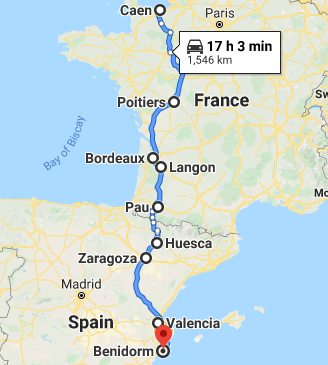
Ideas of where to stop overnight with your Caravan/Motorhome in France
Motorhome stopovers, known as Aires are mostly public parking areas and some private land where motorhome and campervan users may stop overnight for free or for a small fee, New Aires are opening all the time.
Calais - Aire (N50 57 56 E1 50 35) Flat asphalt near harbour
Boulogne - Aire (N50 44 44 E1 35 53) Large paved or gravel area beside D940 north of town.
Le Touquet - Aire (N50 32 10 E1 35 33) Flat asphalt at marina,
Berck-sur-Mer - Aire (N50 23 48 E1 35 50) Flat gravel with 75 bays at Base Nautique.
St-Valery-sur-Somme - Aire (N50 10 55 E1 37 44) Landscaped gravel for 60 vans in quiet area.
Forges-les-Eaux - Aire (N49 36 22 E1 32 33) Flat asphalt for 30 vans.
Pont-de-l’Arche - Aire (N49 18 21 E1 9 27)
Brezolles - Aire (N48 41 26 E1 4 10)
St-Maurice-les-Charency - Municipal Campsite (N48 38 46 E0 45 16) Small flat grass site in village centre
La Suze-sur-Sarthe - Aire (N47 53 20 E0 1 51) Flat gravel for 20 vans beside river close to centre
Chalais - Aire (N46 57 36 E0 6 18)
Vivonne - Aire (N46 25 34 E0 15 47)
Nersac - Aire (N45 37 34 E0 3 0)
Bordeaux - Village du Lac Camping de Bordeaux. (N44 53 52 W-0 34 58) Flat site some hardstands
Sanquinet - Aire (N44 18 38 W-1 5 28) 15 flat gravel pitches.
Biscarrosse - Aire (N44 25 50 W-1 10 5) Sandy gravel for 30 vans beside lake.
Mimizan Plage - Aire (N44 12 18 W-1 17 49) Flat asphalt for 70 vans.
Capbreton - Aire (N43 38 8 W-1 26 48) Spacious flat asphalt for 50 vans.
Anglet - Aire (N43 30 25 W-1 32 1) Sheltered asphalt parking for 50 vans .
Biarritz - Aire (N43 27 56 W-1 34 18) Slight sloping asphalt for 40 vans.
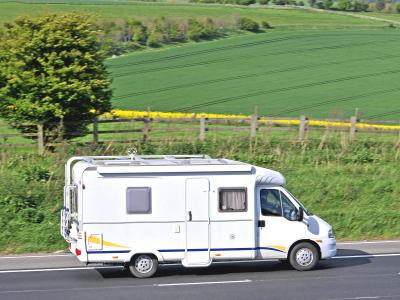
Where to stop overnight in Spain with your caravan/Motorhome
Pamplona - Camping Ezcaba. (N42 51 22 W-1 37 24) Flat grass site beside N121
Pamplona - Aire (N42 50 29 W-1 39 58) In northwest suburb of Berriozar.
Olite - Camping Ciudad de Olite. (N42 28 51 W-1 40 42)
Villafranca - Camping Bardenas. (N42 15 48 W-1 44 19)
Zaragoza - Camping Ciudad de Zaragoza (N41 38 15 W-0 56 34) Municipal site in southwest suburb with flat gravel pitches,
Morella - Aire (N40 37 28 W-0 5 32) Flat gravel free parking for 20 vans directly beside the N232.
Navajas - Camping Altomira (N39 52 29 W-0 30 37)
Driving in France

Fuel is more expensive in France and be very careful when it comes to gas stations in France. Avoid at all costs the ones which ask you to authorize your card at the pump before allowing you to put petrol in the car (Total Stations in particular). They will try to block 150 euros on your card and you will have to prove to your bank that you did not spend that much money on petrol, to get it back. If you need to refuel in France, usually BP is a safe choice.
Driving licence laws in France
Visitors must be aged 18 or over and hold a full, valid driving licence to legally drive in France. Riders of mopeds or motorcycles up to 125cc must be aged 16 or over.
Driving licences issued in EU and EEA countries are accepted. International driving permits are recognised but not required.
Things to take when driving in France
Vehicles from the UK can be temporarily imported into France for up to six months in any period of 12 months. In order to stay on the right side of the law, the following documents should always be carried:
- Full, valid UK driving licence
- Proof of ID (passport)
- Motor insurance certificate
- V5 registration document
Do I need a GB sticker for driving in France?
You will need a GB sticker on your car to drive in France unless it’s equipped with EU number plates, which show the country code in a circle of stars on a blue background.
You will also need a GB sticker or number plate on anything you’re towing.
French 'clean air' stickers (Crit'Air vignettes)
You now need a clean air sticker - called a Crit'Air vignette – displayed on your car when travelling to certain cities.
This six-category sticker system is designed to identify what emissions vehicles produce and are categorised based on your vehicles Euro emissions standard.
Other items for driving in France
You are required by law to carry the following items:
- Reflective jackets – One for each occupant, these must be kept inside the vehicle within easy reach
- Warning triangle – Compulsory in every vehicle with four wheels or more
- Headlamp beam deflectors – Depending on your car, you will either need deflector stickers or have to adjust the beam manually
- Breathalyser/alcohol test – As of January 2013 the French government announced that the introduction of an €11 fine for not carrying one had been postponed indefinitely. However, law still states that drivers and motorcyclists must have an alcotest ready for use in their vehicle even though no penalty will be imposed if they cannot present one during a police road check
- Spare bulbs – It is recommended but not mandatory that you carry a spare bulb kit for your vehicle
- Snow chains – May also be needed in some areas during winter. These areas will be indicated by signs and are compulsory, so it is worth having them in your car if you’re visiting during winter
- Safety helmets – For motorcyclists and their passengers
A French driving kit will have the items you need
If you’re camping, it may also be worth carrying a Camping Card International to give you additional proof of identity, third party liability insurance, plus discounts at a wide range of campsites and tourist attractions.
French rules of the road
Overtaking and passing in France
As a general rule, drive on the right, overtake on the left. However, where traffic is in lanes, vehicles may overtake on the right of other vehicles in slower moving lanes.
On steep gradients, vehicles travelling downhill must give way to vehicles travelling uphill.
Overtaking trams in motion is normally permitted on the right only; it is permitted on the left in one way streets, if there is not enough space on the right.
Who has priority on French roads?
At intersections, you must give way to vehicles approaching from your right, unless otherwise indicated.
Drivers approaching a roundabout must give way to traffic already on the roundabout.
You must also give way to emergency vehicles with flashing lights and sirens.
Warning of approach
Horns may only be used to give necessary warning to other road users.
Between sunset and sunrise, warning must be given by flashing passing lights. The horn may be used only in cases of absolute necessity.
In all built-up areas, use of the horn is prohibited except in cases of immediate danger.
The use of multi-tone horns, sirens and whistles is prohibited.
Towing in France
On a standard driving licence, motorists are allowed to tow a trailer with a maximum authorised mass of 750kg, including the trailer and its load.
You’re not allowed to tow a motor vehicle except in the event of a breakdown or an accident and if the distance to be travelled is short. This practice is banned on motorways where the assistance of a recovery vehicle must be sought.
It is forbidden to carry people in a moving caravan.
France seat belt law
If seat belts are fitted to your car, they must be worn by both drivers and passengers. The driver has a responsibility to ensure that all passengers under the age of 18 are suitably restrained in the car.
The fine for failing to wear a seat belt is set at €135, reduced to €90 if paid within 15 days.
Can I use headphones in my car while driving in France?
As of March 2017, it is illegal to drive a car in France using headphones or earphones. Be sure to take off your headphones once you cross the Channel, otherwise you could be fined on the spot.
Traffic lights in France
The international three-colour traffic light system is used France. However, there is no amber light after the red light.
A flashing amber light indicates caution, slow down or proceed but give way to vehicles coming from the right.
A flashing red light indicates no entry. It may also indicate a level crossing or exit used by emergency vehicles.
If a red light is accompanied by a yellow arrow, you may proceed in the direction indicated by the arrow, provided you give way to vehicles travelling in that direction, as well as to pedestrians.
French speed limits
France uses the metric system for all road signs, meaning speed limits and other road signs including distance are indicated using kilometres and metres.
Speed limits are lowered in rain and other adverse weather conditions, while special speed restrictions apply to certain classes of vehicle, including coaches and cars with trailers, so check before travel.
There is a minimum speed limit of 80 km/h on motorways for vehicles travelling in the outside lane
In an emergency
Important: Because French motorways are privately managed, you’re not allowed to request your own assistance company to attend to you if you break down.
If you do break down, you should use the orange emergency telephones that are situated every 2km along main roads and motorways to call the police or the official breakdown service operating in that area.
Alternatively, if no orange telephone is available, you should call the emergency services by dialling 112.
Driving in Spain Tips
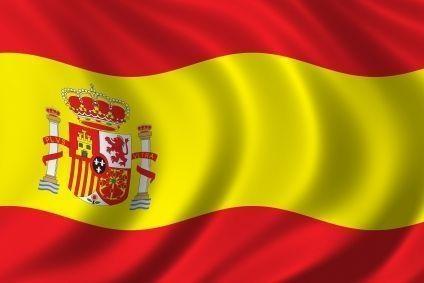
You’ll be driving in the opposite direction, don’t forget that you’ll be driving on the right and anti-clockwise around a roundabout. You should give way to the traffic already on the roundabout.
Carry the correct documents and certain items with you at all times.
Valid UK driving licenses will be accepted in Spain but you must ensure you have at least third-party cover. You should automatically have this with your UK insurance but it is always best to double check.
Make sure you have the following on you at all times:
- Valid driving license - You can drive in Spain on your full UK driving licence (provisional licences are not valid for driving in Spain). Driving licence rules will stay the same until 31 December 2020, after that time international driving permits may be required. Check HERE
- Proof of insurance - If you are taking a vehicle abroad that you’ve hired or leased in the UK, you’ll need a VE103 certificate.
- Proof of ID
- Proof of ownership (if applicable)
It’s the law to carry certain items while you’re driving in Spain – you can receive an on-the-spot fine if you don’t. This includes:
- Warning triangle - V-16 lights to replace emergency triangles - V-16 lights will be able to be used instead of the triangles from July, but they will not become mandatory until 2026.
- Reflective jackets (if you breakdown on a motorway, you can be fined for not wearing one)
- Headlamp converters
- Spare wheel (and the tools required to change it)
Know your speed limits
- Motorways (autopistas) = 75 mph (120 km/h)
- Dual carriageway (autovia) = 62mph (100 km/h)
- Other roads = 56mph (90 km/h)
- Built-up areas = 31mph (50 km/h)
It’s also important to note that there is a minimum speed limit on motorways and dual carriageways of 37mph (60 km/h). In some residential areas, particularly around schools, the speed limit will be 13mph (20 km/h).
Make sure you don’t let your petrol get too low. Ensure you have plenty of petrol, particularly if you’re going to be driving on more rural roads. You’re unlikely to find any petrol stations open through the night and they’ll potentially be closed for a couple of hours over lunchtime too.
Unleaded = 95 octane – green pumps
Diesel = gasoleo – black pumps
You can only use your lights and horn at certain times
Don’t turn your full beam on in built-up areas and make sure you use dipped headlights in tunnels. In urban areas, you can’t use your horn but if necessary, you can flash your lights. It’s also advisable to flash your lights to warn vehicles you intend to overtake and you may notice cars doing this to you.
Wear your seatbelt and make sure children travel in the back
As in the UK, you must wear your seatbelt both in the front and rear seats. Children under 12 are not allowed to sit in the front of the car, unless it is a rear-facing seat for babies.
All children under 12 (or below 1.35 metres tall) must be in a suitable car seat
Spanish Low Emission Zones LEZs - From January 1st, 2023 New low emissions zones are being introduced across 149 towns and cities, find out more HERE
Emergencies:
Emergency telephones linked to an SOS telephone network are installed at two km intervals along the motorways.
Useful numbers:
- 112 - you can dial 112 from anywhere in Europe and an operator will connect you to an emergency service in the country you're visiting. Operators can answer your call in their native language, English, and French
WHATS YOUR PREFERRED ROUTE? COMMENT BELOW



